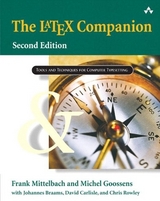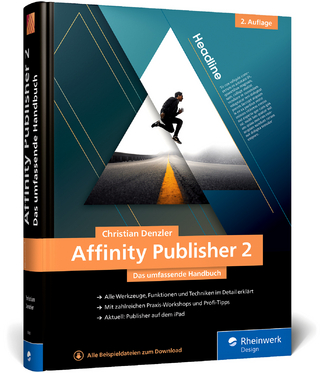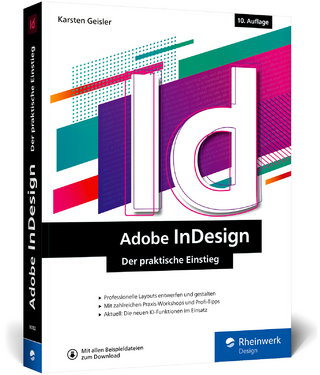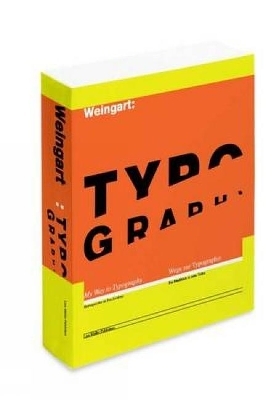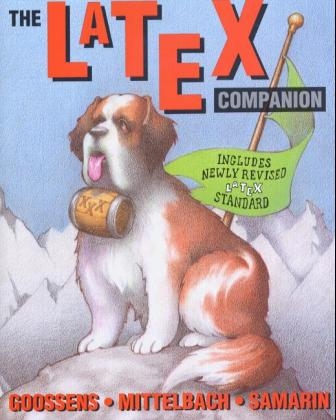
The LaTeX Companion
Addison Wesley (Verlag)
978-0-201-54199-1 (ISBN)
- Titel erscheint in neuer Auflage
- Artikel merken
LaTeX is an accessible and effective tool for typesetting written documents. Users at all levels of experience, however, sometimes require help not readily available: techniques for defining new commands, styles for producing tables or graphics, explanations for changing fonts. This book, The LaTeX Companion, is packed with information needed to use LaTeX even more productively. It is a true companion to Leslie Lamport's original user's guide book, LaTeX: A Document Preparation System, now in its second edition, and indeed, it is a valuable complement to any LaTeX introduction. It is designed to enhance, not to replace, your basic documentation. Coinciding with the publication of The LaTeX Companion is the availability of a revised LaTeX standard LaTeX2e. This new release incorporates important LaTeX developments over the past several years and provides a common basis for all LaTeX enhancements. Some new styles, improved font handling, and a facility to produce PostScript graphics are included in the release. As part of the broad and unique coverage of this book you will find a complete documentation for all these added features.
Highlights *Covers all versions of LaTeX now in use, including LaTeX2e. *Describes over 150 convenient styles for floats, graphics, tables, and much more. *Shows how to define new commands and environments. *Explains the use of PostScript. *Covers the latest extensions and programs producing pictures, indexes, bibliographies, and advanced mathematics. *Includes techniques for multi-language support. *Describes the New Font Selection Scheme. For even more information about how to illustrate documents with TeX and PostScript, see The LaTeX Graphics Companion and the Tools and Techniques for Computer Typesetting Series. All three authors have for years been involved in the support and development of LaTeX applications. Michel Goossens and Alexander Samarin, developed ideas for The LaTeX Companion while supporting hundreds of LaTeX users at CERN, and Frank Mittelbach, at the University of Mainz and Electronic Data Systems. The questions most frequently posed to them became the questions answered in this book.
Mittelbach is partly responsible for the current maintenance of LaTeX and is the author or coauthor of many widespread LaTeX extension packages, such as AMS-LaTeX, doc, multicol, and the New Font Selection Scheme. He is also the manager, principal architect of the longer-term LaTeX3 project, to which half the royalties from this book are paid. 0201541998B04062001
Michel Goossens is past president of the TeX Users Group. A research physicist at CERN, where the Web paradigm was born, he is responsible for LaTeX, HTML, SGML, and, more recently, XML support for scientific documents. Frank Mittelbach is manager of the LaTeX3 Project, in which capacity he oversaw the release of LaTeX 2e. He is the editor of a series of publications on tools and techniques for computer typesetting. 0201541998AB11042003
1. Introduction.
A Short History of TEX and LaTeX.
In the Beginning There Was TeX.
Then Leslie Lamport Developed LaTEX.
With LaTeX toward the Year.0?
LaTeX and Its Components.
How Does LaTeX Work?
Output Processors.
The Concept of Generic Markup.
What Is Generic Markup?
Advantages of Generic Markup.
Separation of Content and Form.
Necessity of Layout Markup.
Pitfalls of Layout Markup.
When to Use Layout Markup.
2. The Structure of a LaTeX Document.
The Structure of a Source File.
Processing of Options and Packages.
Splitting the Source File into Parts.
Combining Several Files.
Logical Structure.
Sectioning Commands.
Numbering Headings.
Formatting Headings.
Changing Fixed Heading Texts.
Structure of the Table of Contents.
Typesetting a Contents List.
Entering Information into the Contents Files.
Defining a New TOC-Like File.
Multiple Tables of Contents.
Managing References.
varioref — More Flexible Cross-References.
References to External Documents.
3. Basic Formatting Tools.
Phrases and Paragraphs.
letterspace — Changing Inter-Letter Spacing.
ulem — Emphasize via Underline.
xspace — Gentle Spacing after a Macro.
Paragraph Justification.
doublespace — Changing Inter-Line Spacing.
picinpar — Typeset a Paragraph with a Rectangular Hole.
shapepar — Typeset a Paragraph with a Specified Shape.
List Structures.
Modifying the Standard Lists.
Making Your Own Lists.
Simulating Typed Text.
alltt — A Verbatim-Like Environment.
verbatim — A Style for Literal Text.
moreverb — More Verbatim-Like Environments.
Footnotes, Endnotes, and Marginals.
Customizing Footnotes.
Marginal Notes.
Endnotes.
Using Multiple Columns.
multicol — A Flexible Way to Handle Multiple Columns.
Typesetting in Columns.
Customizing the multicols Environment.
Floats and Footnotes in multicol.
ftnright — Right Footnotes in a Two-Column Environment.
Simple Version Control.
4. The Layout of the Page.
Geometrical Dimensions of the Layout.
Changing the Layout.
Page Layout Packages.
Typesetting Pages in Landscape Mode.
Page Styles.
Writing New Page Styles.
Customizing Page Styles with fancyheadings.
Visual Formatting.
5. Tabular Material.
Comparing the tabbing and tabular Environments.
Using the tabbing Environment.
The program Environment.
array — Extending the tabular Environments.
Examples of Preamble Commands.
Style Parameters.
Defining New Column Specifiers.
Some Peculiarities of the array Implementation.
tabularx — Automatic Calculation of the Column Widths.
delarray — Specifying Delimiters Surrounding an Array.
Multipage Tabular Material.
supertab — Making Multipage Tabulars.
longtable — Sophisticated Multipage Tabulars.
A Final Comparison.
Bells and Whistles.
dcolumn — Defining Column Alignments.
hhline — Combining Horizontal and Vertical Lines.
Applications.
Hyphenation in Narrow Columns.
Footnotes in Tabular Material.
Managing Tables with Wide Entries.
Columns Spanning Multiple Rows.
Tables Inside Tables.
Two More Examples.
6. Mastering Floats.
Understanding Float Parameters.
Improved Float Control.
float — Creating New Float Types.
I Want My Float “Here!”
Different Kinds of Floating Environments.
floatfig — Narrow Floating Figures.
wrapfig — Wrapping Text around a Figure.
subfigure — Figures inside Figures.
endfloat — Place Figures and Tables at the End.
Customizing Your Captions.
7. Font Selection.
Introduction to NFSS.
Understanding Font Characteristics.
Monospaced and Proportional Fonts.
Serifed and Sans Serif Fonts.
Font Families and Their Attributes.
Encoding Schemes.
Using Fonts in Text.
Standard NFSS Font Commands.
Combining Standard Font Commands.
Font Commands versus Declarations.
Accessing All Characters of a Font.
Changing the Default Text Fonts.
LaTeX 2.09 Font Commands.
Using Fonts in Math.
Special Math Alphabet Identifiers.
Text Font Commands in Math.
Mathematical Formula Versions.
Standard Packages.
Providing New Text Fonts.
Providing New Math Fonts.
slides — Producing Overhead Slides.
Processing Older Documents.
Special Packages for NFSS.
The Low-Level Interface.
Setting Individual Font Attributes.
Setting Several Font Attributes.
Automatic Substitution of Fonts.
Using Low-Level Commands in the Document.
Setting Up New Fonts.
Overview.
Declaring New Font Families and Font Shape Groups.
Modifying Font Families and Font Shape Groups.
Declaring New Encoding Schemes.
Internal File Organization.
Declaring New Fonts for Use in Math.
The Order of Declaration.
Warning and Error Messages.
8. Higher Mathematics.
The AMSLaTeX Project.
Fonts and Symbols in Formulae.
Names of Math Font Commands.
Mathematical Symbols.
Compound Symbols, Delimiters, and Operators.
Multiple Integral Signs.
Over and Under Arrows.
Dots.
Accents in Math.
Superscripted Accents.
Dot Accents.
Roots.
Boxed Formulae.
Extensible Arrows.
/overset, /underset, and /sideset.
The /smash Command.
The /text Command.
Operator Names.
"mod and Its Relatives.
Fractions and Related Constructions.
Continued Fractions.
Big-g-g-g Delimiters.
Matrix-Like Environments and Commutative Diagrams.
The cases Environment.
The Matrix Environments.
The Sb and Sp Environments.
Commutative Diagrams.
Alignment Structures for Equations.
The align Environment.
The gather Environment.
The alignat Environment.
The multline Environment.
The split Environment.
Alignment Environments as Parts of Displays.
Vertical Spacing and Page Breaks in Equation Structures.
The /intertext Command.
Miscellaneous.
Equation Numbers.
Resetting the Equation Counter.
Fine-Tuning Spacing in Math Mode.
A Few Points to Note.
Options and Sub-Packages to the amstex Package.
AmSLaTeX Document Classes.
Examples of Multiple-Line Equation Structures.
The split Environment.
The multline Environment.
The gather Environment.
The align Environment.
Using the align and split Environments within gather.
Using the alignat Environments.
Extensions to the theorem Environment.
Defining New Theorem Environments.
Examples of the Definition and Use of Theorems.
Special Considerations.
Mathematical Style Parameters.
Controlling the Size of Characters.
LaTeX Math Style Parameters.
9. LaTeX in a Multilingual Environment.
TEX and Non-English Languages.
The Virtual Font Mechanism.
Babel — LaTeX Speaks Multiple Languages.
The User Interface.
The german Option.
The Structure of the babel Language Style Files.
Implementing Typographic Rules.
Traditional French Typographic Rules.
Commands of the french Package.
Structure of the french Package.
10. Portable Graphics in LaTeX.
Ornaments.
Boxed Minipages.
Shadow Boxes.
Fancy Frames.
The picture Environment.
Bezier Approximations.
Putting Multiple Boxes.
Drawing Binary or Ternary Trees.
Drawing Bar Charts.
Examples of the barenv Environment.
Drawing Arbitrary Curves.
Other Packages.
Enhancements to the picture Environment — epic.
Description of the Commands.
Extending the epic Package.
eepic's Extensions to LaTeX.
eepic's Extensions to epic.
New Commands with eepic.
Compatibility.
Examples.
Packages Based on epic.
Drawing Bipartite Graphs.
Drawing Trees.
11. Using PostScript.
The PostScript Language.
About the Language.
What Is Encapsulated PostScript?
dvips — A DVI to PostScript Converter.
Merging Text and PostScript Graphics.
Simple Figures.
Draft Figures.
More Complex Figure Arrangements.
Rotating Material.
Rotating Tabular Material.
Rotating a Figure.
Rotated Captions Only.
Using Revision Bars.
The User Interface.
Changebar Parameters.
Deficiencies and Bugs.
Boxing and Gray Shading.
Color Output.
Overlaying Text on the Output Page.
The NFSS Revisited.
Naming Those Thousands of Fonts.
The PSNFSS System.
Using the PostScript Pi Fonts.
Generic Commands in the Style pifont.
The Symbol Font.
Setting Up New PostScript Fonts Yourself.
Replacing AllTeX Fonts with PostScript Fonts.
DCPS — The Cork Encoding with PostScript Fonts.
12. Index Generation.
Syntax of the Index Entries.
Simple Index Entries.
Generating Subentries.
Page Ranges and Cross-References.
Controlling the Presentation Form.
Printing Those Special Characters.
Points to Note.
Consistency and Index Entries.
Preparing the Index.
Generating the Raw Index.
Generating the Formatted Index.
Running the MakeIndex Program.
Detailed Options of the MakeIndex Program.
Error Messages.
Customizing the Index.
Example of Index Style Files.
A Stand-Alone Index.
Changing the “Special Characters.“
Changing the Output Format of the Index.
Treating Funny Page Numbers.
Glossary Entries.
Modifying the Layout.
Multiple Indexes.
A Reimplementation of the Index Commands.
13. Bibliography Generation.
Entering the Citations.
Customizing the Citations.
Customizing the Bibliography Labels.
Using BibTeX with LaTeX.
A List of BibTeX Style Files.
Examples of BibTeX Styles.
Multiple Bibliographies in One Document.
The chapterbib Package.
The bibunits Package.
Bibliography Data Base Management Tools.
The General Format of the bib File.
The General Format of a BibTeX Entry.
The Text Part of a Field Explained.
Abbreviations in BibTeX.
A BibTeX Preamble.
Cross-References.
Some Further Remarks.
Detailed Description of the Entries.
Understanding BibTeX Styles.
A General Description of a BibTeX Style File.
The BibTeX Style File Commands.
The Built-In Functions.
The Documentation Style btxbst.doc.
Introducing Small Changes in a Style File.
Adding a New Field.
Foreign Language Support.
makebst — Customizing Bibliographic Style Files.
Running makebst.
14. LaTeX Package File Documentation Tools.
Documenting Package Files.
The User Interface for the doc Package.
General Conventions.
Describing New Macros and Environments.
Cross-Referencing All Macros Used.
Producing the Actual Index Entries.
Additional Bells and Whistles.
The Driver File.
A Simple Example of a File Documented with doc.
The docstrip Utility.
Batch File Commands.
Conditional Inclusion of Code.
An Example of an Installation Procedure.
APPENDICES.
Appendix A: LaTeX Overview for Package and Class Writers.
Linking Markup and Formatting.
Defining New Commands.
Defining New Environments.
Defining and Changing Counters.
Defining and Changing Space Parameters.
Page Markup — Several Kinds of Boxes.
LR Boxes.
Paragraph Boxes.
Rule Boxes.
Manipulating Boxed Material.
Package and Class File Structure.
The Identification Part.
The Initial Code Part.
The Declaration of Options.
The Execution of Options.
The Package Loading Part.
The Main Code Part.
Special Commands for Package and Class Files.
Special Commands for Class Files.
calc — Arithmetic Calculations.
ifthen — Advanced Control Structures.
Appendix B: TEX Archive Sites.
The Main TEX Internet Sites.
Mail Servers.
TEX User Groups.
Bibliography.
Index. 0201541998T04062001
| Erscheint lt. Verlag | 10.2.1994 |
|---|---|
| Verlagsort | Boston |
| Sprache | englisch |
| Maße | 186 x 234 mm |
| Gewicht | 838 g |
| Themenwelt | Informatik ► Grafik / Design ► Desktop Publishing / Typographie |
| Mathematik / Informatik ► Informatik ► Theorie / Studium | |
| Informatik ► Weitere Themen ► LaTeX | |
| ISBN-10 | 0-201-54199-8 / 0201541998 |
| ISBN-13 | 978-0-201-54199-1 / 9780201541991 |
| Zustand | Neuware |
| Informationen gemäß Produktsicherheitsverordnung (GPSR) | |
| Haben Sie eine Frage zum Produkt? |
aus dem Bereich
